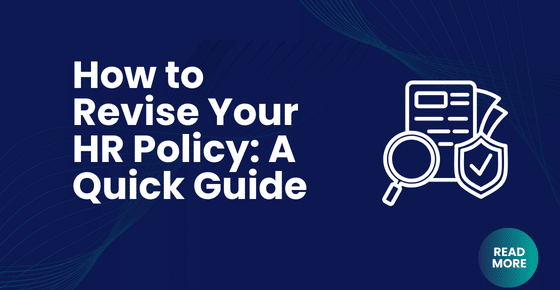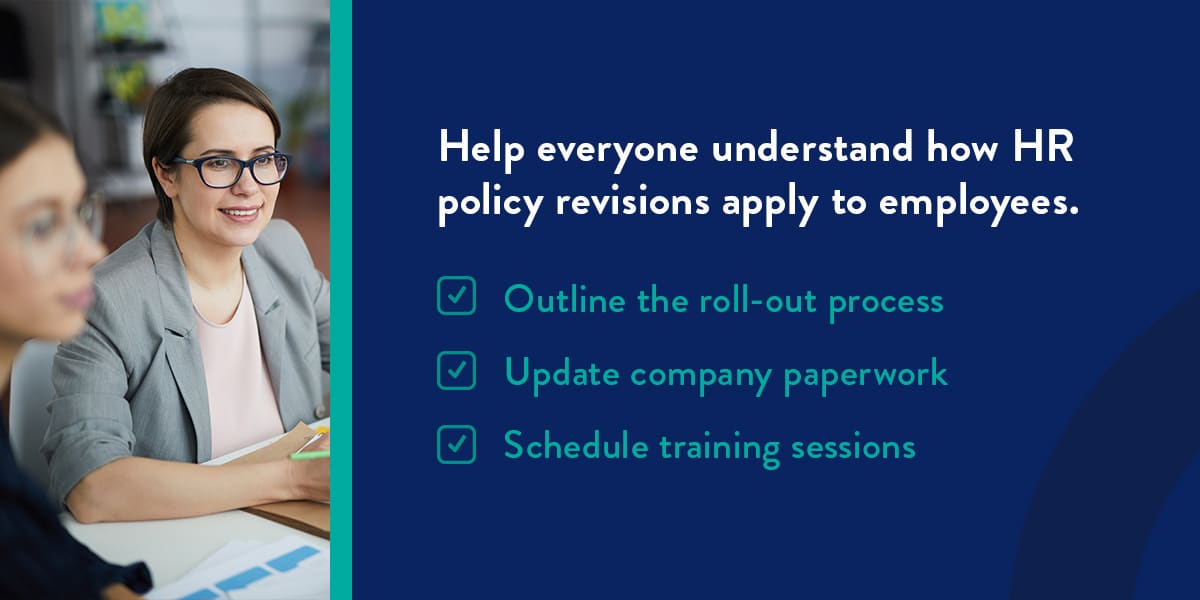Human Resources
How to Revise Your HR Policy: A Quick Guide

Human resources (HR) policies help to achieve a safe and productive workplace. Reviewing and revising your policies regularly is key to ensuring they reflect any legal, cultural and organizational changes.
We explore how to revise an employee handbook in this helpful guide, enabling you to easily understand and complete this process with the best practices in mind. Learn more about this procedure and keep your company compliant with the insights below.
Policy Review Process
The review process involves analyzing current policies for inaccurate content or information gaps. Here’s an overview of the steps HR should take to complete this task.
Initial Assessment
Companies typically have multiple policies outlining topics such as workplace conduct, compensation and health and safety. HR will need to gather all current policies and make them accessible for review.
During the assessment stage, HR officers can identify outdated information. For example, a policy about landline phone usage will be irrelevant if the company now uses Voice over Internet Protocol (VoIP) technology. Flagging obsolete content will help HR focus its efforts where they matter most.
Stakeholder Feedback
Your policies have a direct impact on employee experiences, and requesting worker feedback is highly valuable. Similarly, top management may have suggestions for new policies that could improve staff performance.
HR officers can obtain feedback through surveys, individual interviews or focus groups. Providing a channel for anonymous feedback is also useful, especially when reviewing policies on anti-harassment or discrimination. Once HR has collected the team’s suggestions, they can identify trends and apply them to the revision process.
Compliance and Legal Considerations
Companies operating in the United States must comply with federal employment laws. In addition, each state has its own regulations and requirements to ensure fair working conditions.
As laws and regulations constantly evolve, it’s paramount that HR note any legal changes when reviewing policies. Consulting a legal expert is worthwhile to ensure compliance and avoid penalties.
How to Revise an HR Policy
Once your HR team has completed the initial assessment stage, they can update the policies.
Our step-by-step guide helps you understand how a policy gets revised.
1. Draft the Policy Revision
Appoint an HR officer to write the new policy. They should integrate stakeholder feedback and current legislation during the writing process. Some other tips include:
- Prioritize concision: Use clear and short sentences to avoid any confusion. If your policy contains any jargon or company terms, provide a brief explanation.
- Follow a logical structure: Make it easier for employees to absorb new information by including headings and subheadings. Bulleted lists also help to break down new procedures.
- Connect your objectives: Policies have an integral role in shaping your culture. Ensure your writing reflects your values and organizational goals.
2. Review With Stakeholders
After finalizing the policy drafts, they must undergo a thorough review. Involving HR, top management and legal representatives in this process will help you gain a comprehensive perspective.
Use the feedback to make further revisions before sending the policies to the board of directors for final approval.
3. Communicate Changes

Frequent communication helps everyone understand how HR policy revisions apply to employees. Here are some tips to convey new changes:
- Outline the roll-out process: Your employees will appreciate being informed. Share everything from your intent to revise policies to dates for implementation. It’s best to convey this information in writing and hold team discussions for clarification.
- Update company paperwork: Along with updating official policies, you will need to incorporate the new information in the employee handbook and other materials. For example, if you’ve revised your diversity and inclusion statement, displaying this information on job advertisements and your website can be beneficial.
- Schedule training sessions: Some policy changes may require employees to learn new systems through training and development initiatives. Host workshops or break-out groups to ensure everyone feels confident with the new procedures.
4. Implement New Policies
Remind employees about new procedures in the lead-up to the policy implementation date. In addition, it’s a good idea to request staff to sign a document stating they have read and are accepting the policy terms. This is an effective way of ensuring all team members know how HR policy revisions apply to them and the changes they’ll need to make in the future.
HR will also need to determine a method for checking compliance. For example, they could develop a performance checklist and ask managers to assess how their teams rank against the criteria.
5. Evaluate Effectiveness
While HR teams will likely take every precaution to ensure the revised policy is effective, there may be some concerns. Establish channels for employees and management to share their feedback and be willing to make necessary amendments.
Company leaders are also instrumental in ensuring policy acceptance. By modeling compliance and reinforcing the standards consistently, managers and executives drive change within the organization.
6. Set a Review Date
Scheduling a renewal date is essential for keeping your policies compliant. Setting a date in advance will help your team prioritize reviewing labor laws and revising documents accordingly.
In addition, regular reviews help HR update each part of the employee handbook. Providing staff with consistent information minimizes confusion and prompts them to work independently.
Inclusivity Measures in HR Policies
More and more businesses are placing a stronger emphasis on diversity and inclusion in the workplace. Policies are yet another way in which you can reinforce these values.
Some ways to prioritize inclusivity in HR policies include:
- Use gender-inclusive language: Instead of using pronouns that denote a specific gender, opt to use “they,” “theirs” and “them.” In addition, role titles should be inclusive of all genders.
- Recognize different family structures: Family units can consist of same-sex couples, adopted children and appointed caregivers. Acknowledge all family structures and ensure equality of benefits.
- Make policies accessible: Providing an online and hardcopy version of a new policy helps to make them more accessible. International companies could also consider publishing them in multiple languages.
- Review for unconscious bias: People are sometimes unaware of the stereotypes they project. Appoint a diverse review team to scan policies and identify subjective content.
- Allow reasonable accommodations: While policies should apply to all employees, there may be some exceptions. Consult with senior management and make allowance for reasonable accommodations.
Review Your Policies With Our Expert Support
Policies are living documents, meaning companies must constantly review and edit them. Along with the helpful tips for revising an employee handbook and policies in this guide, your organization may need extra help — especially if you want to amend your policies to incorporate new laws or if your company has recently undergone organizational restructuring.
Exude Human Capital is a consulting firm specializing in human resources. Our expert team possesses in-depth knowledge of federal and state employment legislation, enabling you to remain compliant.
For more information on how we can assist in creating policies that align with your culture, contact our consultants today!








